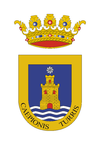Chipiona
| Chipiona | ||
|---|---|---|
| Municipality | ||

Coast of Chipiona with the lighthouse at background
|
||
|
||
 Location of Chipiona |
||
| Location in Andalusia | ||
| Coordinates: 36°44′N 6°26′W / 36.733°N 6.433°WCoordinates: 36°44′N 6°26′W / 36.733°N 6.433°W | ||
| Country |
|
|
| Autonomous community |
|
|
| Province | Cádiz | |
| Comarca | Bajo Guadalquivir | |
| Commonwealth | Municipios del Bajo Guadalquivir | |
| Government | ||
| • Alcalde | Antonio Peña Izquierdo | |
| Area | ||
| • Total | 32.92 km2 (12.71 sq mi) | |
| Elevation | 4 m (13 ft) | |
| Population (2012) | ||
| • Total | 18,849 | |
| • Density | 570/km2 (1,500/sq mi) | |
| Demonym(s) | Chipionero, ra | |
| Time zone | CET (UTC+1) | |
| • Summer (DST) | CEST (UTC+2) | |
| Postal code | 11550 | |
Chipiona is a town and municipality located on the Atlantic coast in the province of Cádiz, Spain. According to the 2012 census, the city has a population of 18,849 inhabitants, but this amount increases greatly during the summer holiday period. The town covers an area of 33 km². Being in the lower valley of the River Guadalquivir it is very flat with a maximum terrestrial height of 4 metres. It is bordered on the north-west by Sanlúcar de Barrameda and on the south-east by the port of Rota.
It is the town of birth of singer Rocío Jurado and where her body now rests.
Chipiona is also home to the tallest lighthouse in Spain and the third tallest lighthouse in Europe. The town is also well known for several varieties of Moscatel.
According to the geographers Strabo (Strabo, III, 1, 9) Pomponius Mela (Mela III, 4), of Ancient Greece and Rome, respectively, a lighthouse existed at the mouth of the Guadalquivir River called Turris Caepionis. This was probably because it was built to instances of the Roman Consul Quintus Servilius Caepion or some of their descendants. The tower acted as a warning for a dangerous place of navigation, and also marked the opening of a navigable river, the Guadalquivir. Traditionally seen in the name of this lighthouse was the name of Chipiona.
This area is further identified as the area in which stood the legendary Ars Gerionis, which was the tomb of Geryon, that stood at the end of a narrow cape that jutted into the sea probably in what is now a reef known as the Stone of Salmedina under Salmedina, or just Salmedina. In all of this there is no more evidence than that of the literature and Roman archaeological findings dating from the second century B.C.
Legend relates that the disciples of St. Augustine in Africa, fleeing the invasion of the Vandals, came by sea to Chipiona with the image of the Virgin of Regla. Tombstones have been found near the Shrine of Our Lady of Regla from the time of the Visigoths. After the Islamization of the Iberian Peninsula in 711, following tradition, the hermits hid the image in a cistern about thirty paces from the citadel, now a monastery. The picture remained hidden until S. XIV in a religious of the Order of St. Augustine found, through a revelation from heaven. About the cistern was built a Shrine of Our Lady of Regla.
...
Wikipedia


